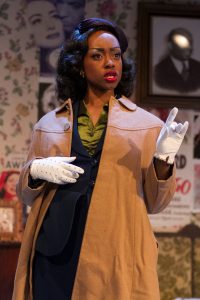MOXIE’s good ‘Crumbs’ examines race through a young black heroine’s eyes
Actors Olivia de Havilland, Joan Crawford, Gloria Swanson and Ingrid Bergman were franchises unto themselves in the late ’40s and early ’50s. Movies like The Snake Pit, Flamingo Road, Sunset Boulevard and Joan of Arc painted their characters in incandescent colors—these were impulsive, unrelenting, sometimes pathologically codependent, sometimes hopelessly deranged victims of (or victors over) their lots in life, colossal screen presences over which young girls swooned. Their posters pepper the living room walls of Godfrey Crump’s home in 1950 Brooklyn, in begrudging deference to Crump’s daughters.
Spiritual leader Father Divine, after all, lives on the wall too, and his gruff admonitions about stuff like dancing, tobacco, alcohol and sex (even during marriage) have taken root amid Godfrey’s grief over his wife’s recent death.
MOXIE Theatre’s current Crumbs from the Table of Joy, running through March 2, takes it from there, declaring in earnest that life—specifically that of a 17-year-old black girl and her coming of age in society—is anything but a movie. That declaration isn’t without its potential pitfalls, because this play sometimes threatens to talk itself to death. But there’s an up side to that as well—it shows that playwright Lynn Nottage has done her due diligence. The performers (two in particular) hold up their end in this very busy, well-helmed story about race, impending adulthood and survival in what’s often a cold, cruel world.

Godfrey Crump (Vimel Sephus, left) offers a cookie to Gerte, his eventual bride, but she’s not biting. Photos by Daren Scott.
Widower Godfrey has brought daughters Ernestine and Ermina to Brooklyn from racist Pensacola, Fla. to be closer to Father Divine’s Mission, his place of religious solace, as he desperately seeks forgiveness of his sins and instructions on being a dad. Central character Ernestine, who narrates this memory piece, is full of youth-fueled questions Godfrey can’t or won’t answer—and who should muddy the waters but Lily Ann Green, Godfrey’s bigmouth sister-in-law and a legendary drinker, who’d promised to move in and look after the kids should mom die. Problem is, she brashly espouses everything Godfrey eschews (feminism, communism, sexual freedom and the fight for racial equality).
Things come to a boil when Godfrey brings home his new wife, Gerte, a white German immigrant whose straitlaced stoicism in the face of wartime horror runs Lily back to Harlem. The family suffers another setback when Ernestine graduates high school; nearly immediately, she leaves home for Harlem in search of Lily. As in the film characters’ lives, what she discovers isn’t pretty—but ever the trouper, and often unlike in the movies, she’ll take in the experience for the object lesson it is.

Trash-talkin’ Lily Ann Green (Cashae Monya) is a thorn in everybody’s side, especially Godfrey Crump’s.
Nottage has a substantial idea, and she certainly sees it through, but she sometimes misplaces her story in favor of subtext that belongs in the background. An attack on Godfrey and Gerte by a group of white idiots; the sexual tension between Lily and Godfrey; the look and feel of the lace on Ernestine’s graduation dress: The playwright isolates these and other scenes for effect rather than for the progression of the story, threatening to splinter the script into playlets. There’s a world of stuff going on here, and Nottage and director Delicia Turner Sonnenberg (who helmed MOXIE’s absolutely superb A Raisin in the Sun two years ago) get nods for their hard-won sense of containment (Nottage often exercises hers in the nick of time).
All that dialogue, though, translates to juicy roles, specifically that of Lily. Cashae Monya is positively excellent at reflecting an Angela Davis before her time—she gives us lots of fiery histrionics behind that clipped speech, petite frame and mobile face. Vimel Sephus has the right idea in his forlorn Godfrey, especially in the second act, although his bullhorn voice sometimes threatens to explode the set. Jennifer Eve Thorn’s good Gerte is an intelligent, conciliatory sort, but we could use some more about her wartime past to help shape the character.
The interaction between Ernestine and Ermina is wonderful, mostly because it never stoops into predictable adolescent hijinks—and Jada Temple’s Ernestine holds that spirit throughout. Temple creates a perfectly wonderful superhero to Deja Fields’ spunky sidekick, almost oracular in her outlook and skillfully consistent in her bearing. Temple and Fields are students at the San Diego School of Creative and Performing Arts; Temple, 17, will graduate in June and plans to give New York a shot this fall.

Ermina and Ernestine Crump (Deja Fields and Jada Temple) trot out one of those “what’d we do now?” looks.
The dowdier the effects in this show, the better, hence Tim Nottage’s set, Jennifer Brawn Gittings’ costumes, Ross Glanc’s lights and Melanie Chen’s sound. Jennifer Berry’s choreography is efficient amid all those muted accouterments.
Godfrey’s “They white” mantra is sad and resolute at the same time, and the real misfortune is that it’s all too familiar. In the last two generations, race relations in America have improved exponentially on the surface, but the topic still makes us nervous. Good theater like this Crumbs offers insight into the reasons behind the discomfiture, fueling a young heroine’s maiden voyage toward her best and highest hope.

Martin Jones Westlin, principal at editorial consultancy Words Are Not Enough and La Jolla Village News editor emeritus, has been a theater critic and editor/writer for 25 of his 47 years…
More…


